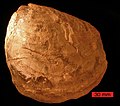An editor has nominated this article for deletion. You are welcome to participate in the deletion discussion , which will decide whether or not to retain it. |

| Part of a series on |
| Paleontology |
|---|
 |
Index fossils (also known as guide fossils or indicator fossils) are fossils used to define and identify geologic periods (or faunal stages). Index fossils must have a short vertical range, wide geographic distribution and rapid evolutionary trends. Another term, "zone fossil", is used when the fossil has all the characters stated above except wide geographical distribution; thus, they correlate the surrounding rock to a biozone rather than a specific time period.









